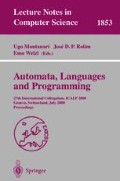Abstract
A constructive version of Hausdorff dimension is developed and used to assign to every individual infinite binary sequence A a constructive dimension, which is a real number cdim(A) in the interval [0, 1]. Sequences that are random (in the sense of Martin-Löf) have constructive dimension 1, while sequences that are decidable, r.e., or co-r.e. have constructive dimension 0. It is shown that for every Δ0 2-computable real number α in [0, 1] there is a Δ0 2 sequence A such that cdim(A) = α. Every sequence’s constructive dimension is shown to be bounded above and below by the limit supremum and limit infimum, respectively, of the average Kolmogorov complexity of the sequence’s first n bits. Every sequence that is random relative to a computable sequence of rational biases that converge to a real number β in (0,1) is shown to have constructive dimension H(β), the binary entropy of β.
Constructive dimension is based on constructive gales, which are a natural generalization of the constructive martingales used in the theory of random sequences.
This work was supported in part by National Science Foundation Grant 9610461.
Access this chapter
Tax calculation will be finalised at checkout
Purchases are for personal use only
Preview
Unable to display preview. Download preview PDF.
References
J. Cai and J. Hartmanis. On Hausdorff and topological dimensions of the Kolmogorov complexity of the real line. Journal of Computer and Systems Sciences, 49:605–619, 1994.
G. J. Chaitin. On the length of programs for computing finite binary sequences. Journal of the Association for Computing Machinery, 13:547–569, 1966.
G. J. Chaitin. On the length of programs for computing finite binary sequences: statistical considerations. Journal of the ACM, 16:145–159, 1969.
G. J. Chaitin. A theory of program size formally identical to information theory. Journal of the Association for Computing Machinery, 22:329–340, 1975.
K. Falconer. The Geometry of Fractal Sets. Cambridge University Press, 1985.
F. Hausdorff. Dimension und äusseres Mass. Math. Ann., 79:157–179, 1919.
A. N. Kolmogorov. On tables of random numbers. Sankhyā, Series A, 25:369–376, 1963.
A. N. Kolmogorov. Three approaches to the quantitative definition of ‘information’. Problems of Information Transmission, 1:1–7, 1965.
A. N. Kolmogorov. Combinatorial foundations of information theory and calculus of probabilities. Russian Mathematical Surveys, 38:29–40, 1983.
G. Kreisel. Note on arithmetical models for consistent formulae of the predicate calculus. Fundamenta Mathematicae, 37:265–285, 1950.
L. A. Levin. On the notion of a random sequence. Soviet Mathematics Doklady, 14:1413–1416, 1973.
M. Li and P. M. B. Vitányi. An Introduction to Kolmogorov Complexity and its Applications. Springer-Verlag, 1997.
D. W. Loveland. The Kleene hierarchy classification of recursively random sequences. Transactions of the American Mathematical Society, 125:497–510, 1966.
D. W. Loveland. A new interpretation of von Mises’ concept of a random sequence. Zeitschrift für Mathematische Logik und Grundlagen der Mathematik, 12:279–294, 1966.
J. H. Lutz. Dimension in complexity classes. In Proceedings of the Fifteenth Annual IEEE Conference on Computational Complexity. IEEE Computer Society Press, 2000.
P. Martin-Löf. The definition of random sequences. Information and Control, 9:602–619, 1966.
P. Martin-Löf. Complexity oscillations in infinite binary sequences. Zeitschrift für Wahrscheinlichkeitstheory und Verwandte Gebiete, 19:225–230, 1971.
P. Odifreddi. Classical Recursion Theory. Elsevier, 1989.
B. Ya. Ryabko. Noiseless coding of combinatorial sources. Problems of Information Transmission, 22:170–179, 1986.
B. Ya. Ryabko. Algorithmic approach to the prediction problem. Problems of Information Transmission, 29:186–193, 1993.
B. Ya. Ryabko. The complexity and effectiveness of prediction problems. Journal of Complexity, 10:281–295, 1994.
C. P. Schnorr. A unified approach to the definition of random sequences. Mathematical Systems Theory, 5:246–258, 1971.
C. P. Schnorr. Zufälligkeit und Wahrscheinlichkeit. Lecture Notes in Mathematics, 218, 1971.
C. P. Schnorr. Process complexity and effective random tests. Journal of Computer and System Sciences, 7:376–388, 1973.
A. Kh. Sheń. The frequency approach to the definition of a random sequence. Semiotika i Informatika, 18:14–42, 1982. (In Russian.).
A. Kh. Sheń. On relations between different algorithmic definitions of randomness. Soviet Mathematics Doklady, 38:316–319, 1989.
R. J. Solomonoff. A formal theory of inductive inference. Information and Control, 7:1–22, 224–254, 1964.
R. M. Solovay, 1975. reported in [?].
L. Staiger. Kolmogorov complexity and Hausdorff dimension. Information and Computation, 102:159–194, 1993.
L. Staiger. A tight upper bound on Kolmogorov complexity and uniformly optimal prediction. Theory of Computing Systems, 31:215–229, 1998.
S. A. Terwijn. Personal communication, 2000.
M. van Lambalgen. Random Sequences. PhD thesis, Department of Mathematics, University of Amsterdam, 1987.
V. G. Vovk. On a randomness criterion. Soviet Mathematics Doklady, 35:656–660, 1987.
Author information
Authors and Affiliations
Editor information
Editors and Affiliations
Rights and permissions
Copyright information
© 2000 Springer-Verlag Berlin Heidelberg
About this paper
Cite this paper
Lutz, J.H. (2000). Gales and the Constructive Dimension of Individual Sequences. In: Montanari, U., Rolim, J.D.P., Welzl, E. (eds) Automata, Languages and Programming. ICALP 2000. Lecture Notes in Computer Science, vol 1853. Springer, Berlin, Heidelberg. https://doi.org/10.1007/3-540-45022-X_76
Download citation
DOI: https://doi.org/10.1007/3-540-45022-X_76
Published:
Publisher Name: Springer, Berlin, Heidelberg
Print ISBN: 978-3-540-67715-4
Online ISBN: 978-3-540-45022-1
eBook Packages: Springer Book Archive

